 SINAI PENINSULA, EGYPT – “Do you have a bottle of
Johnny Walker Black Label?” asked the bearded Greek
Abbot. He wore a black robe with a hood draped over his
face. That allowed him to stare at me with impatience as
I checked into the women’s dormitory at the Monastery
of Saint Catherine in the Sinai.
SINAI PENINSULA, EGYPT – “Do you have a bottle of
Johnny Walker Black Label?” asked the bearded Greek
Abbot. He wore a black robe with a hood draped over his
face. That allowed him to stare at me with impatience as
I checked into the women’s dormitory at the Monastery
of Saint Catherine in the Sinai.
Since I was unable to produce the J.W., the monk lost interest in me. His attention went to the German standing behind me, who seized a bottle from his pack like a magician and handed it to him. Not an auspicious start.
Saint Catherine is the oldest independent church in the world tucked snugly at the foot of Mount Sinai, where Moses met with God face to face and received the Ten Commandments. Christians, Jews and Muslims hold a deep respect and affection for this territory. Because of this, the Sinai has always been an area with a spirit of tolerance.
Saint Catherine herself was for centuries one of the most popular Christian saints. She was a brilliant philosopher and mathematician.
During the religious persecutions in the fourth
century, Catherine tried to convert the Roman Emperor
from paganism. She did not succeed but astonished him
with her knowledge. In his anger, he put her under guard
with 50 learned men who were charged with dissuading her
from Christian belief. Her arguments were so brilliant
that she converted them. Later she was tortured and put
to death. After five centuries, a monk had a vision in
which her body was lifted by angels to a peak near Mount
Sinai, now known as Mount Catherine. In the ninth
century, monks found her body intact and oozing a kind
of sweet-smelling oil that had healing properties. Saint
Catherine’s day is celebrated on the anniversary of
her martyrdom, Nov. 25.
For more than 1,600 years, the monks have lived their
austere and remote lives. Armies have come and gone.
Invaders and enemies have been turned into protectors
and friends by the monks. During Napoleon Bonaparte’s
stay in Egypt in 1798, the monks obtained his protection
from the French. In the 19th century Muhammed Ali,
founder of modern Egypt, continued a long standing
tradition of Muslim rulers, protecting the monastery and
the monks.
Today, the monks are fighting a battle with the heavy-handed Egyptian bureaucracy. The Egyptian government is desperately looking for new tourist attractions (away from the problem areas of Upper Egypt, which is being plagued by terrorists), For example, cable cars and other development projects are planned within the sacred area in which the monastery is located.
An agreement is pending between the monks and the Egyptian government. But, according to Aymen, a local journalist, “Egypt is a country where documents are signed easily but no one takes them seriously. And finding the person in charge of anything can be an impossible task, as no one wants to take responsibility.” The monks will continue to resist change and to defend their heritage and institution. They are aware that negotiating with the Egyptian government could be a no-win situation; no wonder some of the monks are hitting the whiskey bottle.
MOUNT SINAI, (MOUNT MOSES)
The mountain towers over Saint Catherine’s Monastery to a height of 7,540 feet. According to Christian tradition, Mount Sinai (Mount Horeb of the Bible) is where Moses received the tablets of the law. Miriam, a 60 year old doctor from India, and I decided to climb the mountain together. She dreamed of climbing this mountain once in her life. Two paths lead to the summit. The path that looked shorter was difficult to climb. The road was very steep, curvy and rocky. If you find yourself taking this path, by choice or accident, be sure to have good insurance. The purpose of this road is to punish monks who have sinned.
The doctor and I decided to take the longer and slightly less torturous path. Halfway up, I tried to persuade the good doctor to walk back down with me, by telling her that Moses had his vision halfway up and that if you didn’t have to climb to the summit, Miriam was unconvinced. “I must get to the top. It has been my vision all my life,” she said She was so stiff-headed. When you think you are almost there, the hardest part of the climb is just beginning. A crude flight of about 3,000 blue-black granite steps leads on and on. As you get closer to the summit, you can hear (it could have been my imagination) the echo of the moaning of the people who have gone before you.
All along the path you will find Bedouins ready to put you in the saddle of their camel, offer you tea, and cheer you on, although they can take you only to the steps leading to the summit. Miriam and I spent the night on top of Mount Sinai. The world was at our feet. The desert was an ocean of sand shaking off its heat before nightfall. Saudi Arabia shimmered across the Red Sea. One can easily imagine how Moses received his vision from God. The climb was torture, but as it did Moses, this awe-inspiring place could have moved me enough to part the Red Sea too.
There are several ways of getting to Saint Catherine’s Monastery in the Sinai. Entrance from Israel is at the border town of Taba, which is on the northwest coast of the Gulf of Agaba. A collective taxi will take you to the monastery in three hours. A Sinai-only visa is available at Taba. Visas are required of all travelers to Egypt. In Tel Aviv, Israel, The Egyptian Embassy is at 50 Rehov Basel. You need two photos and at least $20. Be aware that if you have an Israeli stamp in your passport, you will not be able to get in Jordan, Syria, Sudan, Yemen, or other Arab countries, including some African nations.
From Egypt, Air Sinai operates regular flights from Cairo to the monastery. Two daily buses from Cairo to Saint Catherine’s leave from the Sinai Terminal.
Christina Henning
